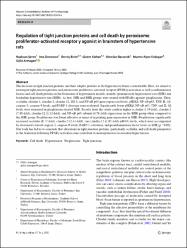Regulation of tight junction proteins and cell death by peroxisome proliferator-activated receptor γ agonist in brainstem of hypertensive rats

View/
Access
info:eu-repo/semantics/embargoedAccessDate
2023Author
Şeren, NazlıcanDovinova, Ima
Birim, Derviş
Kaftan, Gizem
Barancik, Miroslav
Erdoğan, Mümin Alper
Armağan, Güliz
Metadata
Show full item recordCitation
Şeren, N., Dovinova, I., Birim, D., Kaftan, G., Barancik, M., Erdogan, M. A., & Armagan, G. (2023). Regulation of tight junction proteins and cell death by peroxisome proliferator-activated receptor γ agonist in brainstem of hypertensive rats. Naunyn-Schmiedeberg's Archives of Pharmacology, 1-11.Abstract
The decrease in tight junction proteins and their adapter proteins in the hypertensive brain is remarkable. Here, we aimed to investigate tight junction proteins and peroxisome proliferator-activated receptor (PPARγ) activation as well as inflammation factors and cell death proteins in the brainstem of hypertension models, namely spontaneously hypertensive rats (SHR) and borderline hypertensive rats (BHR). At first, SHR and BHR groups were treated with PPARγ agonist, pioglitazone. Then, occludin, claudin-1, claudin-2, claudin-12, ZO-1, and NF-κB p65 gene expression levels; pIKKβ, NF-κB p65, TNF, IL-1β, caspase-3, caspase-9 levels, and PARP-1 cleavage were evaluated. Significantly lower pIKKβ, NF-κB p65, TNF, and IL-1β levels were measured in pioglitazone-treated SHR. Results from this study confirm higher occludin (1.35-fold), claudin-2 (7.45-fold), claudin-12 (1.12-fold), and NF-κB p65 subunit (4.76-fold) expressions in the BHR group when compared to the SHR group. Pioglitazone was found effective in terms of regulating gene expression in SHR. Pioglitazone significantly increased occludin (8.17-fold), claudin-2 (2.41-fold), and claudin-12 (1.85-fold) mRNA levels, which were accompanied by decreased cleaved caspase-3, caspase-9 levels, PARP-1 activation, and proinflammatory factor levels in SHR (p ˂ 0.05). Our work has led us to conclude that alterations in tight junction proteins, particularly occludin, and cell death parameters in the brainstem following PPARγ activation may contribute to neuroprotection in essential hypertension.















